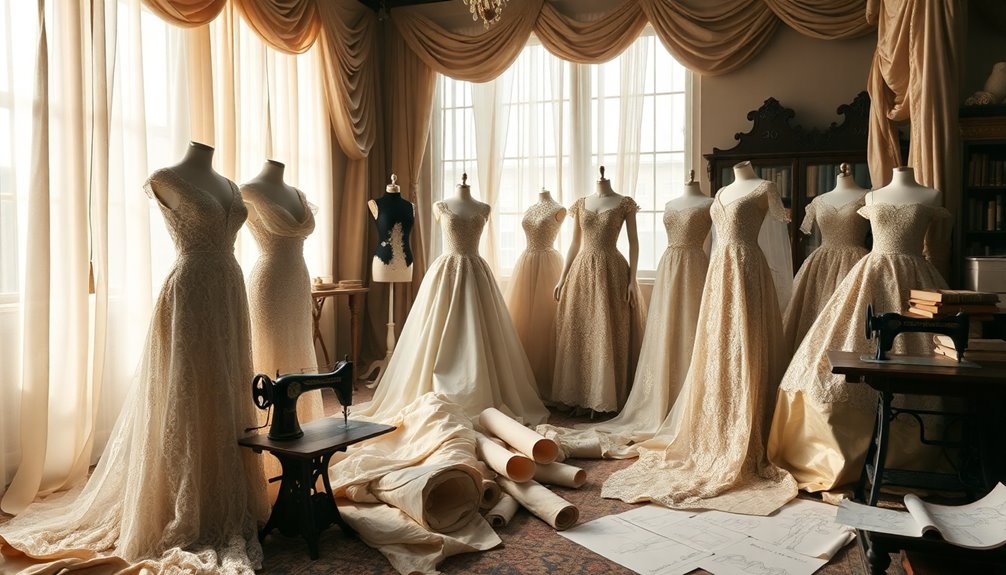If you're curious about the father of haute couture, you need to meet Charles Frederick Worth. Born in England in 1825, he revolutionized fashion by founding the first true fashion house in 1858. Worth introduced live models for his designs, creating a dynamic presentation that changed the industry. He also established the concept of seasonal collections, keeping clients excited and engaged. With the support of high-profile patrons like Empress Eugénie, Worth set new standards for elegance and luxury. His legacy continues to influence modern fashion today, and there's much more to explore about his remarkable journey and impact.
Key Takeaways
- Charles Frederick Worth, born in 1825, is recognized as the father of Haute Couture for founding the first fashion house in 1858.
- He revolutionized the industry by introducing live models for clothing presentations, enhancing the shopping experience for clients.
- Worth established seasonal collections, creating a structured calendar that transformed fashion consumption and maintained client interest.
- His designs, including the bustle and princess line silhouette, set new standards for luxury and bespoke tailoring in fashion.
- Worth's connection with Empress Eugénie elevated his status, making his salon a social hub for elite women and influencing high fashion trends.
Early Life of Charles Frederick Worth

From humble beginnings, Charles Frederick Worth was born on October 13, 1825, in Bourne, Lincolnshire, England, into a financially struggling family.
At just 11, you'd find him working in a printer's shop, where he began to learn the value of hard work. Later, he completed an apprenticeship with London textile merchants, gaining essential knowledge about fabrics and textiles.
In 1845, he relocated to Paris, facing numerous challenges before landing a sales position at Gagelin. There, he seized the opportunity to open a dressmaking department.
Worth's participation in major exhibitions, including the Great Exhibition of 1851, further boosted his reputation, laying the groundwork for his future as a pioneer in the fashion industry.
Establishing the Fashion House

In 1858, Charles Frederick Worth took a bold step by establishing the first fashion house, which marked a turning point in the fashion world.
You'll find that this wasn't just any ordinary business; it set the standard for luxury and bespoke tailoring. Worth revolutionized how clothing was presented by introducing live models, allowing clients to visualize garments in motion.
He also began the practice of creating seasonal collections, keeping fashion fresh and exciting. This innovative approach to design and marketing attracted high-profile clients and established lasting relationships.
Innovations in Fashion Design

Charles Frederick Worth didn't just stop at establishing a fashion house; he also transformed the very foundation of fashion design.
You'll appreciate how he pioneered the use of live models, turning clothing presentations into dynamic events that engaged clients. He created iconic designs like the bustle and princess line silhouette, prioritizing both expressiveness and comfort in women's fashion.
Worth even introduced sewing labels in garments, which elevated designers' status and identity. By establishing seasonal collections, he shaped the fashion calendar, ensuring new styles constantly captivated clientele.
His innovative marketing strategies forged lasting connections between designers and clients, revolutionizing the way fashion was experienced and consumed.
Worth's contributions laid the groundwork for the fashion industry as we understand it today.
Seasonal Collections Revolution

Revolutionizing the fashion landscape, Worth introduced the concept of seasonal collections, a game-changer that fundamentally altered how clothing was designed and marketed.
You may not realize it, but this innovation created a structured calendar for fashion releases, keeping clients enthusiastic for new styles. Instead of static offerings, you now have the thrill of anticipating fresh designs each season.
Worth's collections encouraged designers to think creatively and differentiate their work, pushing the boundaries of fashion. This shift not only maintained client interest but also established a rhythm in the fashion industry that persists today.
Influence of Empress Eugénie

Empress Eugénie's patronage was a turning point for Charles Frederick Worth, catapulting his designs into the limelight of high fashion. By commissioning over 250 dresses for the grand opening of the Suez Canal, she transformed Worth's creations into symbols of prestige. This relationship mirrored the way contemporary artists often explore socio-political issues through their work, as Worth's designs became a canvas for expressing the elegance of the era.
Her support made his designs essential at court and public events, intertwining his reputation with her royal status.
Here are three ways Eugénie's influence changed fashion forever:
- Trendsetter: She set the standard for elegance, prompting society to enthusiastically adopt Worth's styles.
- Social Hub: Worth's salon became a gathering place for elite women, enhancing his status.
- Cultural Impact: The Empress showcased how fashion could reflect power and identity, reshaping societal views on couture. Additionally, her role in promoting haute couture exemplified the importance of establishing healthy boundaries in the fashion industry, allowing designers like Worth to flourish creatively.
Marketing Strategies in Couture

The rise of Charles Frederick Worth as a leading designer wasn't just about his innovative creations; it also stemmed from his savvy marketing strategies that reshaped the couture landscape.
He recognized the importance of showcasing his designs with live models, transforming static presentations into dynamic fashion shows that captivated potential clients. Worth's introduction of seasonal collections kept his clientele enthusiastic and engaged, as they anticipated each new offering.
By emphasizing bespoke tailoring and personalized service, he built strong relationships with elite clients, ensuring their loyalty. Additionally, his strategic collaborations with influential figures, like Empress Eugénie, elevated his brand prestige.
Worth's marketing tactics laid the groundwork for the designer-client dynamic we see in today's fashion world, making him a pioneer in the industry. His approach to celebrity lifestyles demonstrated how personal connections could significantly influence brand perception and desirability.
Lasting Legacy in Modern Fashion

While many designers have left their mark on fashion, few have done so as profoundly as Charles Frederick Worth. His innovative spirit paved the way for the haute couture industry, setting standards that still resonate today.
Worth's influence can be felt in various aspects of modern fashion:
- Seasonal Collections: He established the rhythm of fashion cycles, keeping anticipation alive among clients and ensuring that each collection reflected the changing seasons in haute couture trends. This approach mirrors the astrological influences that shape consumer behavior and preferences throughout the year.
- Custom Fitting: His dedication to individual preferences transformed the tailoring experience, making it personal and luxurious, which remains a hallmark of exclusive fashion today.
- Designer Identity: Worth's introduction of sewing labels elevated the status of designers, creating a legacy of brand recognition that has become essential in the marketing of luxury fashion houses.
These elements are integral to today's fashion landscape, reminding us that Worth's vision continues to inspire and shape the industry we recognize and love. Furthermore, his approach to sustainable fashion has influenced contemporary designers who prioritize eco-friendly practices.
Frequently Asked Questions
What Impact Did Worth Have on Men's Fashion?
While Worth is primarily linked with women's fashion, his influence extended to men's fashion as well.
You'll find he emphasized tailored fits and luxurious fabrics, setting a precedent for bespoke menswear.
His innovative approach to seasonal collections encouraged a more fashionable lifestyle for men, prompting designers to create garments that catered to evolving trends.
How Did Worth Address Sustainability in Fashion?
Worth addressed sustainability by emphasizing quality and bespoke craftsmanship. He believed in creating garments that weren't only beautiful but also durable, encouraging clients to invest in timeless pieces.
Did Worth Collaborate With Other Designers?
Imagine a bustling Parisian salon filled with vibrant fabrics and the excited chatter of elite clients.
Worth didn't collaborate much with other designers, choosing instead to carve his unique path in fashion. He focused on creating exclusive pieces tailored for individual clients, which set him apart.
While he admired the artistry around him, his vision drove him to innovate independently, shaping haute couture as it's understood today.
What Were Worth's Personal Design Philosophies?
When exploring Worth's personal design philosophies, you'll find he emphasized individuality and craftsmanship. He believed in custom fitting, ensuring each piece aligned with a client's unique preferences.
Worth also championed the idea of seasonal collections, keeping fashion fresh and exciting. His innovative use of live models transformed garment presentation, making it an expressive art form.
Ultimately, his vision merged luxury with personal identity, setting a standard for future designers in the fashion industry.
How Is Worth's Influence Seen in Today's Fashion?
You can see Worth's influence in today's fashion through the emphasis on seasonal collections and bespoke designs.
Fashion weeks showcase live models, making presentations dynamic and engaging, just like he pioneered.
The custom fitting and unique designs you often encounter reflect his commitment to individual client preferences.
Additionally, the rise of designer-collaborations and luxury branding stems from his innovative marketing strategies, highlighting how deeply his legacy permeates modern fashion practices.
Conclusion
To sum up, Charles Frederick Worth's influence on fashion is like a thread weaving through time, connecting the past to the present. His pioneering spirit transformed clothing from mere necessity to a canvas of artistry and elegance. By embracing innovation and understanding the desires of his elite clientele, he laid the foundation for the vibrant world of haute couture we cherish today. Worth's legacy continues to inspire designers, ensuring that his vision remains alive in every stitch of modern fashion.










